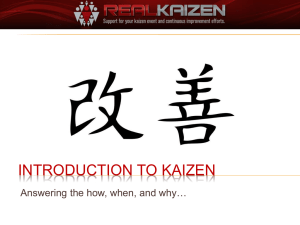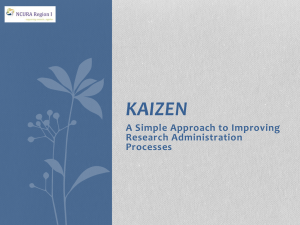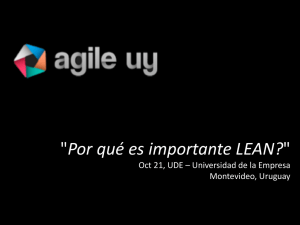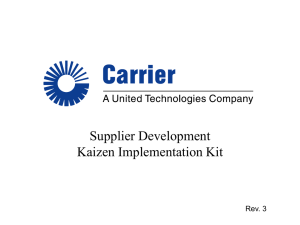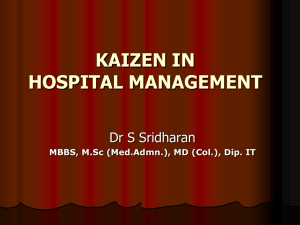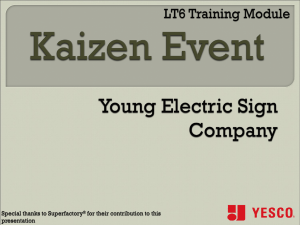KAIZEN
advertisement
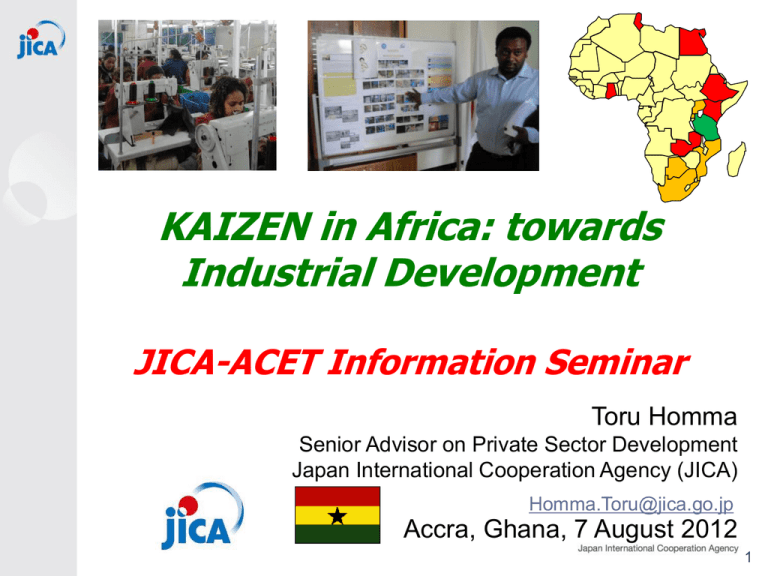
KAIZEN in Africa: towards Industrial Development JICA-ACET Information Seminar Toru Homma Senior Advisor on Private Sector Development Japan International Cooperation Agency (JICA) Homma.Toru@jica.go.jp Accra, Ghana, 7 August 2012 1 Outline 1. KAIZEN and JICA’s Cooperation 2. JICA KAIZEN Project in Ethiopia 3. Other examples on KAIZEN in Africa 4. Wrap up 2 1. KAIZEN and JICA’s Cooperation 3 KAIZEN - spread in the world Kaizen has spread among Japanese companies in Japan and abroad. JICA has also offered assistance for KAIZEN to many developing countries in Asia, Latin America, Eastern Europe and now in Africa! “5S” in many languages Hindi Spanish Indonesian French Vietnamese Arabic Turkish Croatia Montenegro Serbia Bosnia Amharic Thai Khmer Portuguese English Swahili Source: JICA’s World No.28 (2010) 4 1.Seiri(Sort) 2.Seiton(Set) 3.Seiso(Shine) 4.Seiketsu(Standardize) 5.Shitsuke(Sustain) What is KAIZEN? Simply a word which means “improvement” in Japanese Incremental and continuous improvement with the involvement of entire workforce Quality and Productivity Improvement Without additional cost: “If no money, use your brain.” Participatory process and bottom-up from factory floors (gemba) Emphasis on process as well as results Idea of Kaizen is embedded in Japanese work style as well as daily life Source: modified from Masaaki Imai, “Kaizen: The Key to Japan’s Competitive Success”, McGraw-Hill/Irwin, 1986. 5 Kaizen and Innovation Kaizen and innovation complement each other. Quality/Productivity level Kaizen Innovation Kaizen Innovation With Kaizen Innovation Without Kaizen Time Source: Imai (undated), Ueda (2009) 6 KAIZEN tools Kaizen Umbrella Source: Imai (1986), cited in GRIPS (2009). 7 KAIZEN tools 5S For working environment improvement (1) Seiri (sort), (2) Seiton (set), (3) Seiso (shine), (4) Seiketsu (standardise), (5) Shitsuke (sustain) Philosophy and checklist for good housekeeping A variety of translation in English and other languages Muda dori For problem finding and countermeasures Elimination of muda (waste) 7 types of muda: (1) overproduction, (2) inventory, (3) repair/rejects, (4) motion, (5) processing, (6) waiting and (7) transport Source: various cited in GRIPS (2009). 8 KAIZEN tools QC 7 Tools For problem analysis and countermeasures (1) Pareto Chart, (2) Fishbone Chart, (3) Histogram, (4) Graph / Control Chart, (5) Check Sheet, (6) Scatter Diagram, (7) Stratification QC Circle For Suggestio n Box For sustainable improvement and entire involvement Small groups who collectively find a problem, discuss alternative remedies, and propose a solution sustainable improvement and entire involvement Suggestion system for bottom up Source: various cited in GRIPS (2009). 9 KAIZEN tools TQM Total Quality Management TPS Toyota JIT Just-in-time Kamban Signboard: A system/tool SMED Single Production System System (a part of TPS) for JIT Minutes of Exchange of Die …and many more Source: various cited in GRIPS (2009). 10 JICA’s assistance in Kaizen Beginning with the project for Singapore in 1983 Spread from Asia to Eastern Europe, Latin America and Africa JICA has assisted in capacity development of quality/productivity organisations Singapore, Hungary, Brazil, Egypt, Ethiopia etc. Pilot/demonstration + action planning: Tunisia, Ethiopia Regional: Central America - Costa Rica African Union Commission (requested) Others As a component of industrial development project In various sectors: from manufacturing to service such as hospital, electricity and public services Individual experts and senior Volunteers Group training in Japan and third-country training (Malaysia etc.) Source: modified from Ueda (2009). 11 JICA KAIZEN assistance spread in Africa Tunisia LEGEND Project implemented/ing Project officially requested MPC course participated (only for Sub-Saharan) Egypt Ghana Ethiopia Uganda Rwanda Kenya (In addition to the individual countries, African Union Commission is requesting for JICA assistance on Kaizen) Tanzania Zambia Botswana Mozam bique South Africa Source: modified from Homma (2011). 12 Various backgrounds/elements for KAIZEN in Africa (1) i. Policy support and initiative National mid-term plan, industrial strategy … Ethiopia: H.E. Prime Minister’s strong initiative ii. Implementing/related ministry/agency Ministry of Industry: most often observed Ministry of Trade: international competitiveness Ministry of Labour: productivity movement Ministry of Education: TVET system Ministry of Health: hospital Agencies/Centres: Productivity Centre, Development Agency (Zambia ZDA), Small enterprise development agency (Ghana NBSSI) … Specially established organisation: Productivity Centre, Kaizen Centre, Kaizen Unit (Ethiopia, Tanzania), Kaizen Institute (Ethiopia, Zambia) … Source: modified from Homma (2011). 13 Various backgrounds/elements for KAIZEN in Africa (2) iii. Target sector/size Sectors: Manufacturing, others (service, public, hospital …) Sub-sectors: Metal, agro, food, textile, leather … Size: Large, medium, small and micro iv. Existing mechanism BDS provider/facilitator Productivity Centre Management consultant: public, private Private sector organisation v. Contents of KAIZEN programme 5S, Muda elimination, QC Circle … OJT, TOT, pilot project, seminar/workshop … Source: modified from Homma (2011). 14 2. JICA KAIZEN Project in Ethiopia 15 KAIZEN in Ethiopia (Phase I & II) Industrial Policy Support to Ethiopia – Background G8 Hokkaido Toyako Summit (Jul. 2008) TICAD IV (May 2008) Symposium : Economic Development in Africa and the Asian Growth Experience (May 2008) Debate on how to make the Asian Experience relevant with accelerating economic growth in Africa “The Initiative for Policy Dialogue (IPD) Taskforce on Africa Meeting” in Addis Ababa (Jul. 2008) Debate on a more active role of the government in economic policies Introduction of JICA’s KAIZEN Project in Tunisia JICA’s Follow up of Japan’s Commitment to Africa 16 JICA’s Cooperation Framework for Industrial development of Ethiopia Request from Prime Minister Meles (July 2008) Support to formulate industrial development policy for Ethiopia Intellectual exchange of views on industrial development strategy, and policy recommendations from Japan based on the Asian development experience. Support to nurture private companies Technical cooperation of JICA for enhancing competitiveness of the private sector learning from the JICA’s experience in Tunisia. In parallel “Policy Dialogue on Industrial Development” (1st Phase: Jun. 09-May 2011) “The Study Project on Quality and Productivity Improvement (KAIZEN)” (Pilot Phase: Oct. 09-Jun.11) 17 Ethiopia KAIZEN Project Phase I (2009-11) Profile of the project 1. Name: The Project on Quality and Productivity Improvement (Kaizen) in Ethiopia 2. Objective: To formulate a national plan for enhancing activities on quality and productivity improvement for Ethiopian enterprises in industrial sector To formulate a manual for explaining and guiding the quality and productivity improvement activities To transfer relevant skills and techniques to the staff members of the Kaizen Unit, Ministry of Industry 3. Period: 2 years (August 2009~June 2011) 4. Implementing Institutions: - Ministry of (Trade and) Industry (MoTI/MOI) of Ethiopia - Japan International Cooperation Agency (JICA) 18 Ethiopia KAIZEN Project Phase I (2009-11) Major activities Stage 1 • • Situation analysis on quality/productivity improvement activities / Visit to factories for preliminary diagnosis Preparation for the pilot project (Kaizen methodology selection, selection of 30 pilot companies with criteria) Stage 2 Implementation of the pilot project a. to visit the pilot companies to diagnose the situation, and to give guidance on the quality and productivity improvement activity (KAIZEN) with the staff members of the Kaizen Unit, MoTI b. to repeat factory visit periodically and give KAIZEN advice and to monitor the KAIZEN process c. to evaluate the pilot project and compile recommendations to the factories Stage 3 • • Formulation of a National Plan including an Action Plan of KAIZEN Formulation of a Manual 19 Ethiopia KAIZEN Project Phase I some of the achievements obtained in the 30 pilot companies Fig.1 Sort, Set-in-order & Shine (3S) are implemented to standardize the inventory stock Fig. 2 In-process stock is repositioned to avoid Muda of transportation Before Kaizen After Kaizen Source: JICA Study Team (2010) 20 Ethiopia KAIZEN Project Phase I Sample Improvement Results at 30 Pilot Companies Qualitative Results: Clean working environment created, Team work and motivation of workers developed, Health and occupational safety of workers improved, Lower level workers accustomed to suggesting improvement ideas to management decisions – Increased Employee Participation, Knowledge obtained on how to meet quick delivery and to reduce costs. Source: JICA Study Team (2010) 21 Ethiopia KAIZEN Project Phase I Sample Improvement Results at 30 Pilot Companies Quantitative Results Monetary impact from the improvements reported is USD 30,000/company. The reporting ranges from USD 600 to USD 190,000. Example includes: By Reducing costs (a) USD 600/month and (b) USD 4,600/year; By generating additional income of USD 70,000/year; By just decreasing down time USD 12,000, By rectifying raw materials defect used for manufacturing USD 140,000; By identifying, repairing and reusing of usable machines & equipment worth of USD190,000. Non-Monetary Measures of Improvement include: Increasing labor productivity, by reducing time loss for searching tools on average 50%; Note: originally calculated in Reduction of floor space around 50%; Ethiopian currency Birr (ETB) Defect ratio improvement in the range of 50-70%; and converted into USD at the rate: USD1 = approx. ETB 17 Lead time improved in the range of 16 to 90%; Labor saved from 15 to 90%. Source: JICA Study Team (2010) 22 Ethiopia KAIZEN Project Phase I Sample Improvement Results (3) Quantitative Results (examples) Company A (Metal) Recovered additional revenue with an amount of 118,995 birr Company B (Metal) Lead time reduced from 2weeks to 1week Company C (Textile) Reduced wastage of time by 624 min/month Company D (Chemical) Reduced wasters of over production by 50% Motion and movement by 100% Company E (Agro) Decreased flour wastage by 190 qtl of wheat flour Company F (Agro) Produced additional 12,000 lit/day By eliminating 6hours dawn time/day Company G (Agro) By decreasing milk wastage recovered 846 birr/day Source: JICA Study Team (2010) 23 Ethiopia KAIZEN Project Phase I Assessment of Capacity Development of KU members Level 0 I II III IV V Competence no experience of KAIZEN Competent to conduct KAIZEN activities for yourself Competent to guide KAIZEN activities Competent to provide consultancy services on KAIZEN Competent to provide consultancy services on KAIZEN Competent to provide consultancy services on KAIZEN Assignment Before project After project 9 Junior KAIZEN Consultant Assistant KAIZEN Consultant KAIZEN Consultant 3 6 Senior KAIZEN Consultant Lead KAIZEN Consultant Source: JICA Study Team (2010) 24 Ethiopia KAIZEN Project Phase II Project on Capacity Building for Dissemination of Quality and Productivity Improvement (KAIZEN) 1. Project Purpose: The system is established to disseminate quality and productivity improvement (KAIZEN) to private enterprises in a sustainable manner. 2. Period: 3 years (November 2011 - November 2014) 3. Implementing institutions: Ethiopian KAIZEN Institute (EKI: gazetted and established in October 2011, based on the Phase I Project), Ministry of Industry Japan International Cooperation Agency (JICA) 25 Ethiopia KAIZEN Project Phase II Comparison between Phase I and Phase II Phase I Stage Planning with pilot project Phase II Dissemination Impleme Kaizen Unit (KU) nted by Ethiopian Kaizen Institute (EKI) Target Large and Medium Enterprises (LMEs) LMEs + Micro & Small Enterprises (MSEs) Area Addis Ababa and surroundings All Ethiopia Period 2009-11 (2yrs) 2011-14 (3yrs) Scheme Technical Cooperation for Development Planning Technical Cooperation Project Source: Homma (2012) 26 Ethiopia KAIZEN Project Phase II Enterprise supporting system for LMEs and MSEs MoI: Ministry of Industry MoE: Ministry of Education MoUDC: Ministry of Urban Development and Construction EKI: Ethiopia KAIZEN Institute FeTA: Federal TVET Agency ReTA: Regional TVET Agency TTTI:TVET Teacher’s Training Institute TVET: Technical and Vocational Education and Training FeMSEDA: Federal MSE Development Agency ReMSEDA: Regional MSE Development Agency CRC: Cluster Resource Centre LMEs: Large and Medium Enterprises MSEs: Micro and Small Enterprises TTT: TVET Trainers’ Trainer Source: JICA Study Team (2011) 27 Ethiopia KAIZEN Project Phase II Planned KAIZEN dissemination structure Source: JICA Study Team (2011) 28 3. Other examples on KAIZEN in Africa 29 Ghana – KAIZEN as a part of a project for MSE development Project for Formulating a Strategic Model for Quality / Productivity Improvement through Strengthening BDS for MSEs Project period: April 2012 – April 2015 (3 years) Implementing agency: National Board for Small Scale Industries (NBSSI), Ministry of Industry and Trade Utilising and Capacity building of Business Advisory Centres (BACs) and its network Target area: Ashanti Region Overall Goal: Replication of the “Strategic Model” in the whole of Ghana Project purpose: formulation of the “Strategic Model” Function of BDS provision/facilitation Some Kaizen experiences in Ashanti in the past Kaizen as an additional tool of BDS / as a way of thinking 30 Implementation image of Ghana Project MOTI: Ministry of Trade and Industry NBSSI: National Board for Small Scale Industries BAC: Business Advisory Centre GRATIS: Ghana Regional Appropriate Technology Industrial Service RTF: Rural Technology Facility BDS: Business Development ServiceInput the “Strategic Model” to MOTI and NBSSI HDQs MSE: Micro and Small Enterprise NBSSI HDQs Project Purpose: Formulation of the “Strategic Model” GRATIS Ashanti Region MOTI Project Director Deputy Project Director Regional NBSSI Project Manager Project Staff RTF Enhancement of BACs’ capacity BAC MSE ×20 BACs BAC BAC Heads/staff BAC Heads BDS facilitation MSE Private BDS provider BDS BDS MSE BDS MSE MSE Consulting of specific techniques Support BAC’s BDS utilising their technical knowledge and skills cooperation Overall Goal: Replication of the “Strategic Model” in the whole of Ghana Regional NBSSI Output 1: formulation of the system and capability to continuously improve the capacity of BACs’ BDS provision/facilitation Output 2 : Improvement of the capacities of BACs to provide/facilitate BDS by (i) Improving the existing BDS, and (ii) Adding KAIZEN concept to BDS: through OJTs and seminars/workshops Output 3: formulation of the “tools” to be used in the replication of the “Strategic Model” in the whole of Ghana 31 Kaizen in Zambia Started in 2009 with the QC Circle based approach, wider and growing participation of companies / organisations: manufacturing, non-manufacturing and public institutes 1st Zambia National KAIZEN Conference (12-13 Feb 2010) 9 teams from 6 organisations participated 18 QCCs in 4 public, 5 QCCs in 4 non-manufacturing and 20 QCCs in 5 manufacturing in operation in 2010 2nd Zambia National KAIZEN Conference (18-19 Feb 2011) 20 teams from 9 organisations participated 44 QCCs in 12 public (ministries, local councils, colleges), 23 QCCs in 5 non-manufacturing (finance, school, water supplier) and 19 QCCs in 8 manufacturing (various) in operation in 2011 Participated in 36th International Convention on Quality Control Circle (ICQCC) on 11-14 Sep 2011 in Japan (possibly first presentation from Africa) Source: modified from Adachi (2012). 32 Kaizen in Zambia 3rd Zambia National KAIZEN Conference (16-18 Feb 2012) 30 teams from 19 organisations participated 30 QCCs in public, 17 QCCs in education, 16 QCCs in general services and 18 QCCs in manufacturing Currently under the framework of “Zambia Investment Promotion Project - Triangle of Hope” Zambian Government sets up “Kaizen Institute of Zambia (KIZ)” A JICA technical cooperation project to support KIZ and disseminate Kaizen is under formulation in response to the official request by Zambian Government. 33 Source: modified from Adachi (2012). 4. Wrap up 34 Wrap up - Implication How Kaizen spread in the world and Africa: various practices/lessons available in the world Kaizen is: mindset, philosophy, way of thinking tool, technique, methodology Involvement of top management (country, company) Process-oriented, practical, field-oriented, implementation Sustainability – Self-sustainable Learning process and customisation Complementarity with policy dialogue 35 Thank you JICA’s VISION “Inclusive and Dynamic Development” www.jica.go.jp 36 36


